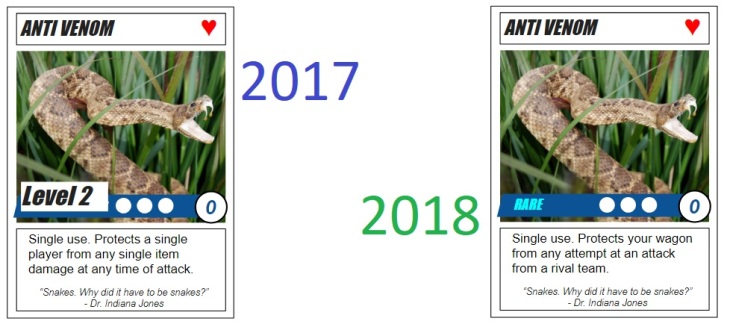 One of my biggest “so close, but not quite” takeaways from last year’s attempt at the gamified classroom was that my existing system of player Power-Up item cards was, sadly, a bit too ambitious for it’s own good. Cards looked super cool, mind you. But students had a hard time knowing when and how they were allowed to play which cards, and found themselves similarly frustrated to discover that certain cards required certain XP levels in order to be played successfully.
One of my biggest “so close, but not quite” takeaways from last year’s attempt at the gamified classroom was that my existing system of player Power-Up item cards was, sadly, a bit too ambitious for it’s own good. Cards looked super cool, mind you. But students had a hard time knowing when and how they were allowed to play which cards, and found themselves similarly frustrated to discover that certain cards required certain XP levels in order to be played successfully.
This year, I’ve decided to simultaneously simplify and overcomplicate my Power Up item system for my yearlong Dream Rush class game. Simpler how? No more cards that require dice rolls to add or remove hit points. No more unnecessary systems of additional record-keeping like health points and gold. No more cards that can be played more than once. And most importantly: no more cards that require players to keep track of individual XP levels in order to play them, which means no more discrepancy over who all is allowed to play which card and when. You want to play a card? You play it. No questions asked.

More complicated how? Inspired by episode 73 of Michael Matera’s outstanding Well PlayED podcast, I’ve ditched the old system of card rankings with level systems in favor of a printed card rarity notice on each Power-Up. Using the same familiar rarity color-coding system that gamers would likely already know from the ubiquitous world of Fortnite, cards are now divided by color-code ranking into one of six categories:
Common – Gray
Uncommon – Green
Rare – Blue
Epic – Purple
Legendary – Orange
Mythic – Gold
Much, much faster. And when printing out new sets of cards for each unit, the rarity ranking tells me exactly how many of each card to print. Six of each common, five of each uncommon, four of each rare, three of each epic (two epics per set), two of each legendary, and one of each mythic (6+5+4+3+3+2+1) = 24 cards per class, per unit.
As an added bonus: in addition to scoring team awards in the form of “GOLD, SILVER, BRONZE, and LEAD” medals (and corresponding XP) for each team-vs-team showdown, all team-based challenges this year will likewise conclude with an award payout in the form of Power-Up Cards where the winners get to select any item of their choice.
With luck, it’ll result in a built-in feedback mechanism, and an ongoing incentive to play Power-Up items harder, faster, and more strategically over time.
Can you share your file for the cards?
Absolutely! https://docs.google.com/presentation/d/1We16M-d4BFhb6DMrjszrJ5H458UAgEFcQTQr2ILF0e8/edit?usp=sharing